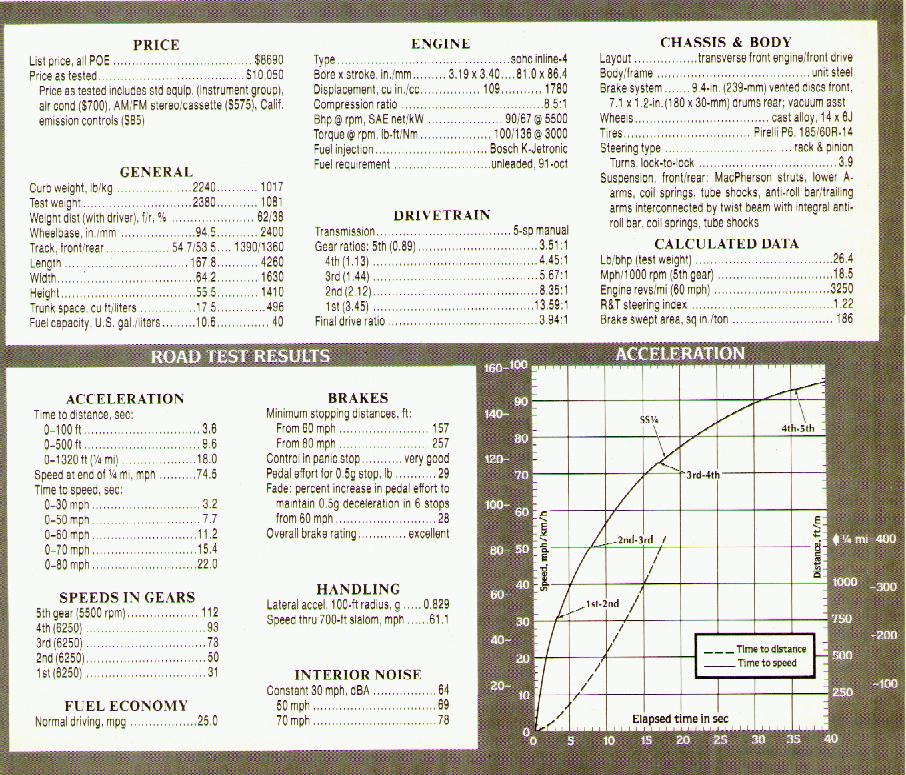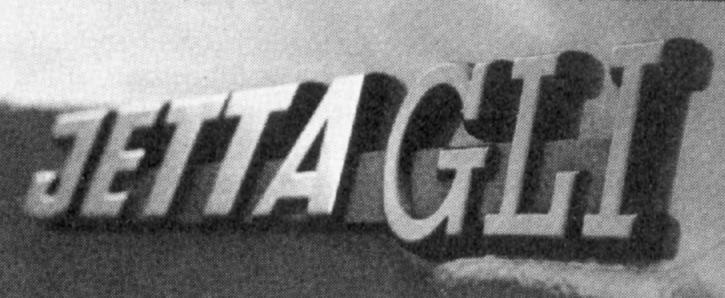
Volkswagen Jetta GLI
A 4-door version of the sporty Rabbit GTI is just what the family man ordered.

Volkswagen Jetta GLI
A 4-door version of the sporty Rabbit GTI is just what the family man ordered.
If you love the Rabbit GTI, you'll love the Jetta GLI. And if you're a family man or woman and need four doors and a spacious trunk, you'll undoubtedly love the GLI even more. The Jetta is, of course, simply a Rabbit with a larger tail, or a "third box" as automotive engineers call trunks these days. And the GLI is simply a Jetta with all the performance package GTI trimmings.
In case you haven't heard, the GTI is the best thing that's happened to Volkswagen's sales since Americans succumbed to the charms of the funky Beetle in the late Fifties. Until the GTI came along, Rabbit sales had been less than hopping, what with fierce competition from Japanese and American econoboxes. And the Rabbit's misfortunes were compounded when the luster wore of the diesel Rabbit; during the current oil glut, car buyers are leaving diesel engines to the Peterbilt and Greyhound customers.
But two years ago, when Volkswagen decided to share with us Yanks a hot version of the Rabbit
similar to the German Rabbit (*Golf*) GTI, sales immediately revived. American GTIs now
account for about 40 percent of all US Rabbit sales and have added zest to a design that's
approaching the decade mark. Because the GTI comes only in 2-door hatchback form, VW
officials decided there was an untapped market for a GTI-type car with four doors and a trunk.
Voila - the Jetta GLI. (*but 2 door GLIs were available as well -Dave*)
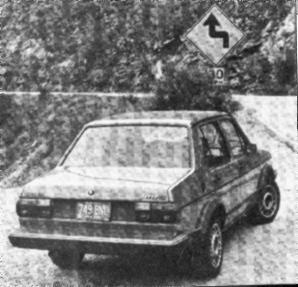
Both the Rabbit GTI and the Jetta GLI represent a new direction for Volkswagen, a turning away from strictly economy cars. "The GTI and GLI are just the beginning," says Jim Fuller, head of VW's sales and marketing in the US. "We're taking Volkswagen further and further along the performance spectrum. by performance, I don't just mean straight-line acceleration. I mean factors like having good passing speed between 40 and 60 mph, and things having to do with active safety, such as braking. You should be able to drive quickly on all types of roads without feeling that you're having to work hard."
The GTI is the embodiment of such a car. When R&T; first tested the GTI at the end of 1982, we called the car, in so many words, one of the best automotive antidepressants around. We discovered that the GTI went from 0-60 mph 2.0 seconds quicker than a normal Rabbit, that on the skidpad it just about equaled a Porsche 911SC and that its ride was comfortably compliant despite the crisp handling. One editor went so far as to declare that the GTI was a car he's be willing to buy with his own money.
Well, the transformation from Jetta to Jetta GLI is just as impressive. On the outside, the GLI has the same matte-black fender flares, blacked out trim and grill, and fat Pirelli P6 tires as the GTI. Inside, there's a pair of sport seats, a leather-wrapped steering wheel and gearshift knob, a tachometer and a set of console-mounted instruments that includes a voltmeter, and oil temperature and pressure gauges.
The seats, instruments and 60-series radials are more than just cosmetic frills. But it's the
changes to the suspension and drivetrain that really make this Jetta fly. The GLI/GTI engine is
the same basic single-overhead-cam 4-cylinder unit found in the standard Jettas and Rabbits, but
bored out 65 cc to 1780 cc. With a revised cylinder head, lighter pistons and slightly higher
compression ratio, this 1.8-liter engine produces 90 bhp versus the 1.7-liter engine's 74 bhp. The
GLI, like the GTI, uses K-Jetronic fuel injection and electronic ignition.
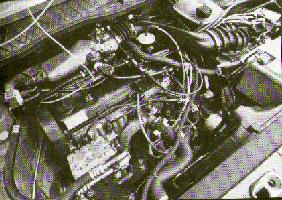
The suspension on all Jettas and Rabbits is fully independent. But the GLI and GTI also have a 16.5 mm front anti-roll bar, a 20.5 mm rear bar, stiffer springs, recalibrated shock valving and handsome 14x6 in alloy wheels. The front brake discs are ventilated instead of solid as on other Jettas and Rabbits. And to complete the switch from Jetta to Jetta GLI, the car has the Rabbit GTI's special close-ratio 5-speed transmission.
That's the package, and it works wonders. A bigger engine with more ponies means better
acceleration: the GLI is quicker nearly a second (11.2 sec versus 12.1). Of course, the Jetta's
trunk adds weight, 180 lb (test weight) more than the Rabbit GTI, so the GLI is not unexpectedly
a half-second slower than the supr bunny. The GLI handles better, too. It went through the
slalom at 61.1 mph, considerably faster than the 57.4 mph of the last Jetta. And the GLI's slalom
speed is just about identical to the Rabbit GTI's. We're not at all surprised that the GLI's skidpad
figures are better than a plain Jetta's, 0.829g versus 0.748g. But we were surprised to find that
the GLI's 0.829g is substantially better than the Rabbit GTI's 0.7997g.
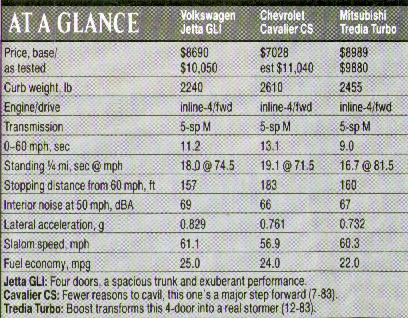
Subjectively, the GLI feels just like the GTI, which is to say, terrific! The GLI is the kind of car that invites you to speed up on the curves. On our favorite mountain road we consistently found ourselves taking turns 7-10 mph faster than we do in most cars. Hers's a car that rates high marks for the ease with which the driver can maintain a fast average speed without extending himself into the pucker zone. Placement options are many and varied because of the exceptional handling, balance, road feel and tenacious grip from the Pirelli P6s. Ultimately, you'll encounter understeer but by that time you're driving at speeds higher than what is typically reasonable and proper.
The GLI's brakes added to our sense of security too. The spongy pedal feel on the last Jetta we tested was gone on the GLI. And the braking distance from 80 mph is considerably improved as well, down from 289 to 257 ft. From 60 mph, it remains the same, a very commendable 157 ft.
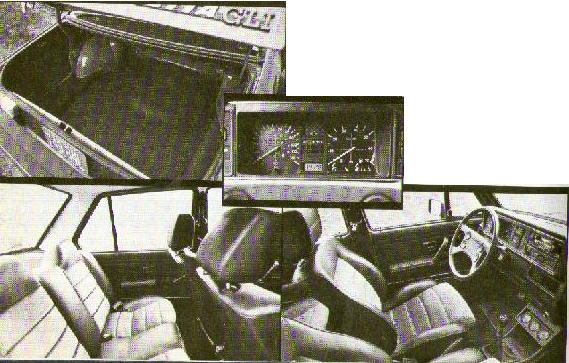
We had only two minor complaints about the GLI's performance. We've always appreciated the Jetta/Rabbit engines because they're such eager revvers. But they do so with more mechanical harshness and noise than we like. In this respect the close-ratio gearbox doesn't help any: it's nice to always have a surge of power with each upshift, but a taller 5th gear would quiet things down a bit. The other complaint also had to do with the transmission. At times 5th gear was elusive because spring tension required a very deliberate movement from 4th to 5th. Other times we had a difficulty finding 1st gear: moving away from a stoplight in 3rd when you think you're in 1st is decidedly unsporting. In any case, the positioning of the shiftlever relative to the driver and seat is not quite right for some drivers. And some attention to pedal placement would be appropriate. The GLI is not especially easy to heel and toe.
Otherwise, the car "for families in a hurry," as VW bills the GLI, is certainly successful as a sports sedan. And how is it as a family sedan? Very accommodating, thank you. Staff members praised the front seats for firmness and support, and the rear seats are nicely contoured as well. For anyone under 6 ft, there's adequate rear-seat leg room. The trunk is not only large, but it's all useful space with no odd-shaped nooks or shallow spots.
The Jetta GLI also scores high on fit and finish. The doors shut with an airtight seal, like those on the old Beetle. Some staff members thought the interior looked too obviously plastic, albeit high quality plastic. Nevertheless, the interior materials, including the plush carpeting and upholstery, a combination of vinyl and velour, appear sufficiently rugged to endure life in a family sedan.
But the real virtue of the GLI is its exuberant performance. In this respect, we're as taken with the GLI as we were with the GTI. Both cars are inbued with the sort of precision found in the best high performance European GTs and sedans. Though Rabbits and Jettas will be restyled for
1985, there will still be GTI and GLI versions. There's no doubt in our minds that the GLI package is worth an extra $840 over the price of a regular 4-door Jetta. In fact, it's not unreasonable to consider the GLI a competitor to another German 3-box sports sedan, the esteemed BMW 318i, a car that costs nearly twice as much as the Jetta.Copied without permission from Road & Track Magazine, July 1984.
